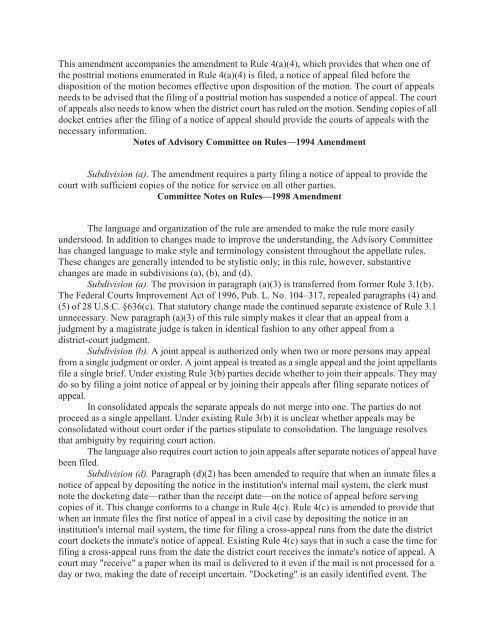Federal Rules of Appellate Procedure 2014-2015, 2014a
Federal Rules of Appellate Procedure 2014-2015, 2014a
Federal Rules of Appellate Procedure 2014-2015, 2014a
You also want an ePaper? Increase the reach of your titles
YUMPU automatically turns print PDFs into web optimized ePapers that Google loves.
This amendment accompanies the amendment to Rule 4(a)(4), which provides that when one <strong>of</strong><br />
the posttrial motions enumerated in Rule 4(a)(4) is filed, a notice <strong>of</strong> appeal filed before the<br />
disposition <strong>of</strong> the motion becomes effective upon disposition <strong>of</strong> the motion. The court <strong>of</strong> appeals<br />
needs to be advised that the filing <strong>of</strong> a posttrial motion has suspended a notice <strong>of</strong> appeal. The court<br />
<strong>of</strong> appeals also needs to know when the district court has ruled on the motion. Sending copies <strong>of</strong> all<br />
docket entries after the filing <strong>of</strong> a notice <strong>of</strong> appeal should provide the courts <strong>of</strong> appeals with the<br />
necessary information.<br />
Notes <strong>of</strong> Advisory Committee on <strong>Rules</strong>—1994 Amendment<br />
Subdivision (a). The amendment requires a party filing a notice <strong>of</strong> appeal to provide the<br />
court with sufficient copies <strong>of</strong> the notice for service on all other parties.<br />
Committee Notes on <strong>Rules</strong>—1998 Amendment<br />
The language and organization <strong>of</strong> the rule are amended to make the rule more easily<br />
understood. In addition to changes made to improve the understanding, the Advisory Committee<br />
has changed language to make style and terminology consistent throughout the appellate rules.<br />
These changes are generally intended to be stylistic only; in this rule, however, substantive<br />
changes are made in subdivisions (a), (b), and (d).<br />
Subdivision (a). The provision in paragraph (a)(3) is transferred from former Rule 3.1(b).<br />
The <strong>Federal</strong> Courts Improvement Act <strong>of</strong> 1996, Pub. L. No. 104–317, repealed paragraphs (4) and<br />
(5) <strong>of</strong> 28 U.S.C. §636(c). That statutory change made the continued separate existence <strong>of</strong> Rule 3.1<br />
unnecessary. New paragraph (a)(3) <strong>of</strong> this rule simply makes it clear that an appeal from a<br />
judgment by a magistrate judge is taken in identical fashion to any other appeal from a<br />
district-court judgment.<br />
Subdivision (b). A joint appeal is authorized only when two or more persons may appeal<br />
from a single judgment or order. A joint appeal is treated as a single appeal and the joint appellants<br />
file a single brief. Under existing Rule 3(b) parties decide whether to join their appeals. They may<br />
do so by filing a joint notice <strong>of</strong> appeal or by joining their appeals after filing separate notices <strong>of</strong><br />
appeal.<br />
In consolidated appeals the separate appeals do not merge into one. The parties do not<br />
proceed as a single appellant. Under existing Rule 3(b) it is unclear whether appeals may be<br />
consolidated without court order if the parties stipulate to consolidation. The language resolves<br />
that ambiguity by requiring court action.<br />
The language also requires court action to join appeals after separate notices <strong>of</strong> appeal have<br />
been filed.<br />
Subdivision (d). Paragraph (d)(2) has been amended to require that when an inmate files a<br />
notice <strong>of</strong> appeal by depositing the notice in the institution's internal mail system, the clerk must<br />
note the docketing date—rather than the receipt date—on the notice <strong>of</strong> appeal before serving<br />
copies <strong>of</strong> it. This change conforms to a change in Rule 4(c). Rule 4(c) is amended to provide that<br />
when an inmate files the first notice <strong>of</strong> appeal in a civil case by depositing the notice in an<br />
institution's internal mail system, the time for filing a cross-appeal runs from the date the district<br />
court dockets the inmate's notice <strong>of</strong> appeal. Existing Rule 4(c) says that in such a case the time for<br />
filing a cross-appeal runs from the date the district court receives the inmate's notice <strong>of</strong> appeal. A<br />
court may "receive" a paper when its mail is delivered to it even if the mail is not processed for a<br />
day or two, making the date <strong>of</strong> receipt uncertain. "Docketing" is an easily identified event. The


















